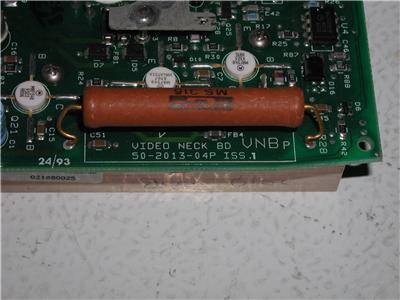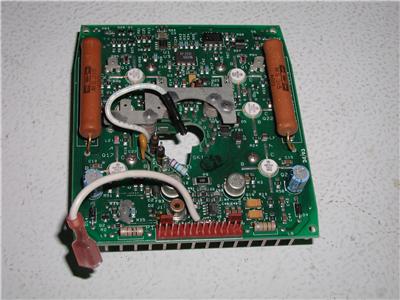3. Neck Boards
OK, let's get started on the neck boards.
Here are some board numbers:
50-2000-02p
50-2013-04p
50-2013-05p


We're not going to use the boards’ part numbers for this. So you'll have to
visually inspect your boards for the following:
- Look for the numbers on IC 'U2' (near the mini RCA jack).
On that IC you should see one of the following numbers: 'CLC409, CLC449,
H1100.
- Check transistors Q12 and Q19, see if they are round
metal (TO-5) devices, or small square (SOIC) devices.
- Check the opposite end of the card for four soldered on
'blue' capacitors.
- Inspect the solder contacts of resistors R13 and R28, for
burn at the point of soldering on the PC boards surface.
- Inspect coils L8 and L9 for any indication of heat
damage.
(1) If IC 'U2' is a CLC409 it should be replaced with IC CLC449. Also if
there's a H1100, it could also have a softening effect on the image, because it
was later replaced with CLC449 (and some H1100's were also on the later boards
8500, 9500's).
(2) If transistors Q12 and Q19 are metal (TO-5) you have an early version
card, and this board would more likely have the CLC409 or H1100 chip.
(3) The 'blue' caps are on the early version boards only, as they were a part
of the upgrade for the brightness blanking problem that was also on the early
version boards. Don't try this fix yourself, this is the protect circuit, and
much care should be taking to prevent tube damage if the procedure is not done
properly (that I won't provide). Also, much care must be taking when servicing
this area of the board. This board SHOULD NOT be used for random modding, it has
special interference tweaks that were necessary for FCC compliance.
(4) If resistors R13 and R28 show burn marks at the solder contacts, replace
capacitors C1 and C26. That burn is an indication of high hour use, and C1 and
C26 would most likely test leaking. The value is 22mfd @ 100 vdc. You can
replace with the same value, but use 105c (high temp) 160 Vdc caps.
(5) Coils L8 and L9 are 100 uh, and would more likely show indication of heat
damage if the same is seen on resistors R13 and R28.

|




